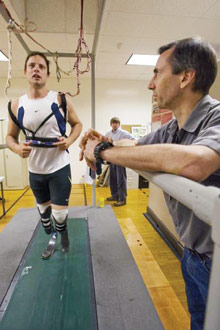
Peter Weyand, PhD, observes Oscar Pistorius on the treadmill at the Rice University Locomotion Laboratory in Houston. Jeff Fitlow/Rice
A team of experts in biomechanics and physiology that conducted experiments on South African Paralympic sprinter and Olympic hopeful Oscar Pistorius have published previously confidential findings in the Journal of Applied Physiology. Some of their findings were presented to the Court of Arbitration for Sport (CAS) in Lausanne, Switzerland in May 2008. Other findings are now being released for the first time.
A portion of the team’s findings had been presented at the CAS to appeal the eligibility ban that had been imposed on Pistorius by the International Association of Athletics Federations (IAAF), which had barred him from sanctioned able-bodied competitions, including the Olympics and World Championships. The IAAF had claimed that the Flex-Foot prostheses worn by Pistorius give him an advantage over able-bodied runners. The international law firm of Dewey & LeBoeuf successfully appealed the decision. The CAS concluded that the IAAF failed to prove that the biomechanical effects of the Cheetah prostheses give Pistorius an advantage over other athletes not using the prostheses.
The authors of the study are Peter Weyand, PhD, of Southern Methodist University; Matthew Bundle, PhD, of the University of Wyoming; Craig McGowan, PhD, of the University of Texas at Austin; Alena Grabowski, PhD; Hugh Herr, PhD, of the Massachusetts Institute of Technology; Mary Beth Brown of Georgia Institute of Technology; and Rodger Kram, PhD, of the University of Colorado at Boulder. None of the authors received compensation for the research or work on behalf of the CAS hearing. The group agreed to conduct the experiments with the understanding that they would be able to publish their scientific findings after the CAS ruling.
The experiments were conducted at the Locomotion Laboratory of Rice University in Houston, Texas. The scientific team compared Oscar Pistorius to track athletes with intact limbs to evaluate his energy cost of running, fatigue resistance, and sprinting mechanics.
The team came to three main conclusions:
- Pistorius’ energy cost of running is similar to that of accomplished male distance runners but is 17 percent lower than that of performance-matched male sprinters.
- Pistorius’ ability to hold his speed over longer sprint races is identical to that of intact-limb athletes.
- Pistorius sprinting mechanics are markedly dissimilar to intact-limb track athletes.
At top speed:
- He exerts considerably less force on the ground in relation to his body weight than intact-limb runners.
- His foot is in contact with the ground 14 percent longer on each sprinting step.
- He spends 34 percent less time in the air between steps.
- He takes 21 percent less time to reposition (swing) his legs between steps.
In summary, the team concluded that Pistorius’ physiology (energy cost and fatigability) is generally similar to that of intact-limb athletes, but his sprint running mechanics are markedly dissimilar.
Weyand, the lead author of the study, commented, “I am pleased that we can now completely disclose our results because our study includes critical new data not presented in the CAS eligibility hearing. In addition to informing an interested public, full disclosure is in the best interests of Oscar Pistorius, other track athletes, and the sport of track and field. The controversy raised by Oscar’s inspiring performances presents a pivotal case for the future regulation of prosthetic and other technology in organized athletics. Accordingly, disseminating all the available facts is essential. I am relieved that all of our data are now available, particularly the mechanical data that are most relevant to the controversy and which were not part of the CAS hearing.




